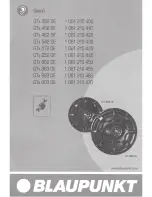
ENGLISH
9
The cabinet surfaces will usually only require dusting. If you wish
to use an aerosol or other cleaner, apply the cleaner onto the
cloth, not directly onto the product and test a small area first,
as some cleaning products may damage some of the surfaces.
Avoid products that are abrasive, or contain acid, alkali or
antibacterial agents. Marks on the paint surface may be removed
with a dilute perfume-free soap solution. Remove any remaining
streak marks by spraying with a proprietary glass cleaner and
lightly wiping dry with a microfibre cloth. Do not use cleaning
agents on the drive units and avoid touching them as damage
may result.
The performance of the speaker will change subtly during the
initial listening period. If the speaker has been stored in a cold
environment, the damping compounds and suspension materials
of the drive units will take some time to recover their correct
mechanical properties. The drive unit suspensions will also loosen
up during the first hours of use. The time taken for the speaker to
achieve its intended performance will vary depending on previous
storage conditions and how it is used. As a guide, allow up to
a week for the temperature effects to stabilise and 15 hours of
average use for the mechanical parts to attain their intended
design characteristics.
However, longer run-in periods (as long as a month) have
been reported and there is evidence to suggest that this has
little to do with the speaker changing and more to do with the
listener getting used to the new sound. This is especially so with
highly revealing speakers such as these, where there may be a
significant increase in the amount of detail compared with what
the listener has previously been used to; the sound may at first
appear too “up front” and perhaps a little hard. After an extended
period of time, the sound will seem to mellow, but without losing
clarity and detail.
5. Running In
6. Aftercare
Summary of Contents for 683 S2
Page 41: ...41 2...
Page 43: ...43 3...
Page 44: ...44 4...
Page 45: ...45 15 5 6...
Page 46: ...46 1 1 1 1 4 M4 4 4 10 1 1 4 M6 35 4 4 i RoHS ii REACH iii WEEE...
Page 47: ...47 2...
Page 49: ...49 3...
Page 50: ...50 4...
Page 51: ...51 15 5 6...
Page 52: ...52 1 1 1 4 10 1 1 M6 x 35mm 4 4 4 i RoHS II REACH iii WEEE...
Page 53: ...53 10 2...
Page 54: ...54 1 5 3 0 5 0 5 0 5 0 5 0 5 EL 5 1 Channels 6 1 Channels 7 1 Channels 0 5m 110 130 40 Stereo...
Page 55: ...55 2 1 2 3...
Page 56: ...56 4...
Page 57: ...57 15 5 6...










































